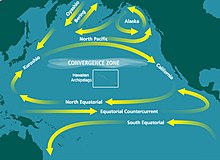
The North Pacific Gyre (NPG) or North Pacific Subtropical Gyre (NPSG), located in the northern Pacific Ocean, is one of the five major oceanic gyres. This gyre covers most of the northern Pacific Ocean. It is the largest ecosystem on Earth, located between the equator and 50° N latitude, and comprising 20 million square kilometers.[1] The gyre has a clockwise circular pattern and is formed by four prevailing ocean currents: the North Pacific Current to the north, the California Current to the east, the North Equatorial Current to the south, and the Kuroshio Current to the west. It is the site of an unusually intense collection of human-created marine debris, known as the Great Pacific Garbage Patch.
The North Pacific Subtropical Gyre and the much smaller North Pacific Subpolar Gyre make up the two major gyre systems in the mid-latitudes of the Northern Pacific Ocean. This two-gyre circulation in the North Pacific is driven by the trade and westerly winds.[2] This is one of the best examples of all of Earth's oceans where these winds drive a two-gyre circulation. Physical characteristics like weak thermohaline circulation in the North Pacific and the fact that it is mostly blocked by land in the north, also help facilitate this circulation. As depth increases, these gyres in the North Pacific grow smaller and weaker, and the high pressure at the center of the Subtropical Gyre will migrate poleward and westward.[2]
- ^ Karl, David M. (1999). "A Sea of Change: Biogeochemical Variability in the North Pacific Subtropical Gyre". Ecosystems. 2 (3). Springer: 181–214. Bibcode:1999Ecosy...2..181K. doi:10.1007/s100219900068. JSTOR 3658829. S2CID 46309501.
- ^ a b Talley, Lynne D.; Pickard, George L.; Emery, William J.; Swift, James H. (2011). Descriptive Physical Oceanography: An Introduction. London: Academic Press. ISBN 978-0750645522.